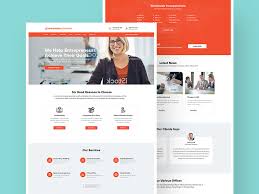
The Importance of Corporate Website Design
In today’s digital age, a corporate website is often the first point of contact between a company and its potential customers. A well-designed corporate website is crucial for making a positive first impression and establishing credibility in the eyes of visitors.
Effective corporate website design goes beyond just aesthetics. It encompasses elements such as user experience, functionality, and branding that work together to create a seamless and engaging online presence.
User Experience
A user-friendly website design is essential for ensuring that visitors can easily navigate through the site and find the information they are looking for. Intuitive navigation, clear calls-to-action, and fast loading times all contribute to a positive user experience.
Functionality
A corporate website should not only look good but also function effectively. This includes ensuring that all links work properly, forms are easy to use, and content is optimized for search engines. A well-designed website should also be responsive, meaning it adapts to different screen sizes and devices.
Branding
Your corporate website is a reflection of your brand identity. The design elements, color scheme, typography, and imagery should all align with your brand guidelines to create a cohesive and memorable online presence. Consistent branding helps build trust and recognition among visitors.
In conclusion, corporate website design plays a crucial role in shaping how your company is perceived online. By investing in a well-designed website that prioritizes user experience, functionality, and branding, you can establish credibility, engage visitors, and ultimately drive business growth.
Top 6 FAQs About Effective Corporate Website Design
- 1. What is the importance of corporate website design?
- 2. How can user experience impact the success of a corporate website?
- 3. What elements should be considered in a well-designed corporate website?
- 4. How does branding influence corporate website design?
- 5. What are the key features of a responsive corporate website?
- 6. How can SEO be integrated into corporate website design for better visibility?
1. What is the importance of corporate website design?
The importance of corporate website design lies in its ability to serve as the digital face of a company, shaping the first impression visitors have and establishing credibility. A well-designed corporate website goes beyond aesthetics; it enhances user experience, ensures functionality, and reinforces branding. User-friendly navigation, clear calls-to-action, responsive design, and consistent branding elements all contribute to a positive online presence that can help build trust, engage visitors, and drive business growth.
2. How can user experience impact the success of a corporate website?
User experience plays a pivotal role in determining the success of a corporate website. A seamless and intuitive user experience can significantly impact how visitors interact with the site, influencing factors such as engagement, conversion rates, and overall satisfaction. By prioritizing user-friendly design elements, clear navigation, fast loading times, and responsive layouts, a corporate website can enhance usability and encourage visitors to explore further, ultimately leading to increased trust, brand loyalty, and business growth.
3. What elements should be considered in a well-designed corporate website?
When considering elements for a well-designed corporate website, several key factors should be taken into account. These include user experience, functionality, and branding. A user-friendly design with intuitive navigation and clear calls-to-action is essential to ensure visitors can easily find information. Functionality aspects such as responsive design, optimized content for search engines, and working links are crucial for a seamless browsing experience. Additionally, aligning design elements like color scheme, typography, and imagery with the company’s branding guidelines helps create a cohesive and memorable online presence that builds trust and recognition among visitors.
4. How does branding influence corporate website design?
Branding plays a significant role in influencing corporate website design. The visual elements, color palette, typography, and imagery used in the design of a website should all align with the company’s brand identity to create a cohesive and consistent online presence. By incorporating branding elements into the website design, companies can reinforce their brand message, values, and personality, thus building trust and recognition among visitors. Consistent branding helps establish a strong connection between the company and its audience, ultimately shaping how the company is perceived online.
5. What are the key features of a responsive corporate website?
When it comes to designing a responsive corporate website, several key features are essential to ensure optimal user experience across different devices. These features include a mobile-friendly layout that adapts seamlessly to various screen sizes, fast loading times to enhance user engagement, intuitive navigation for easy access to information, and touch-friendly elements for mobile users. Additionally, flexible images and media queries help maintain visual appeal and functionality across devices. By incorporating these key features, a responsive corporate website can effectively reach and engage a wider audience while maintaining consistency in branding and usability.
6. How can SEO be integrated into corporate website design for better visibility?
Integrating SEO into corporate website design is essential for improving visibility and driving organic traffic to the site. To enhance SEO, corporate websites should focus on incorporating relevant keywords into meta tags, headings, and content throughout the site. Additionally, optimizing images with descriptive alt text, creating a user-friendly URL structure, and ensuring fast loading times can all contribute to better search engine rankings. By designing a website with SEO best practices in mind, companies can increase their online visibility and attract more potential customers to their site.
